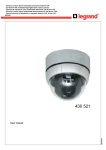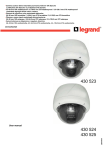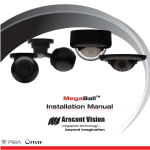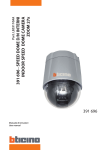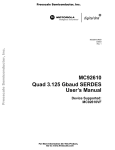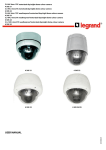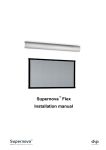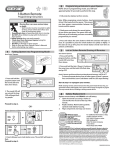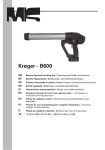Download User manual
Transcript
• Caméra couleur dôme motorisée jour/nuit 3,5-94,5 mm 27X • 3.5-94.5 mm 27X motorized day/night dome colour camera • Cámara de cúpula en color motorizada día/noche 3,5-94,5 mm 27X • Câmara a cores cúpula motorizada diurna/nocturna 3,5-94,5 mm 27X • Kamera kolorowa ze sklepieniem, z napędem, dzień/noc 3,5–94,5 mm 27X 430 522 430 522 LE03666AA User manual FEATURES • Powerful Zoom Camera & Setup Options 27x Optical Zoom, 12x Digital Zoom (324x Max. zoom magnification) High light compensation Privacy Mask Day & Night Focus Mode : Auto-Focus, Manual Focus, Semi-Auto Focus OSD Menu Image Sensor : ¼” Sony interline Transfer CCD • Powerful Pan/Tilt Functions • MAX. 360°/sec High Speed Pan/Tilt Motion • With the Vector Drive Technology, Pan/Tilt motions are accomplished along the shortest path. As a result, the time to target view is remarkably short and the video on the monitor is very natural in monitoring. • With the Micro-Stepping Control Technology, the video looks very natural at high zoom magnification during a jog operation on a controller since the camera can be controlled by 0.05°/sec. Hence it is very easy to make the camera focus on desired target views at high zoom magnification. Additionally it is easy to make the camera focus on desired positions with zoom-proportional pan/tilt movement. • Preset, Pattern, Swing, Group, Privacy Mask and More… • MAX. 127 Presets are programmable and each preset can have its own parameter values independently from the other presets. • For an example, refer to the below table. Preset No. White Balance Auto Exposure Preset 1 Case A Case 3 “ENTRANCE” Preset 2 Case C Case 5 “WAREHOUSE” Preset 3 Case V Case 2 “OFFICE” - - Case K Case 9 ••• Label Remarks ••• Preset 95 - - Reserved for OSD Menu ••• Preset 128 “TERRACE” • MAX. 8 sets of Swing are programmable. This function is that the camera moves repetitively between two preset positions at programmed speeds. • MAX. 4 Patterns are programmable. This function is that the camera memorizes the path (mostly curve path) by the joystick of the controller and revives the trajectory operated by the joystick as closely as possible. • MAX. 8 sets of Group are programmable. This function is that the camera memorizes the combination of Presets, Pattern and/or Swings sequently and runs Presets, Pattern and/or Swings repetitively. A Group can be combined upto 20 functions with any of Preset/Pattern/Swing. • 4 Privacy Masks are programmable, not to intrude on any other’s privacy. 2 • PTZ (Pan/Tilt/Zoom) Control • With the RS-485 communication connection, MAX. 255 units of cameras can be connected to a single controller. • Pelco-D or Pelco-P protocols can be selected as a control protocol in the current firmware version. • OSD (On Screen Display) Menu • • OSD menu is provided to display the status of camera and to configure the functions interactively. The information such as Camera ID, Pan/Tilt Angle, Direction, Alarm Input and Preset is displayed on screen. • Alarm In/Out Function • • • • 4 alarm sensor inputs and 2 alarm sensor outputs relays. Alarm sensor input is decoupled with photo-couplers to avoid external electric noise and shock perfectly. Both of N.O.(Normal Open) sensors and N.C.(Normal Close) sensors can be used and the signal range of the sensor input is from DC 5.0V to 12.0V for various applications. The camera can be set to move to a Preset position or to run functions such as Pattern, Swing and Group when there are external sensor activations. Also “Post Alarm” function is possible, which is supposed to activate after user-defined time period and sequentially in succession to the action by external sensor activations. • Reserved Presets (Hot Keys) • Most camera setup options can be set up easily and directly with the reserved presets (Hot Keys), without entering into OSD menu. For more information, refer to “Reserved Presets (Hot Keys)”. Warning - The installation and calibration of this camera must be carried out by highly skilled personnel. - Do not open the camera: there may be a risk of electric shock. - Low voltage cameras must be powered by a power supply unit with stabilized voltage. This range of cameras has been created for CCTV applications and not for other uses. Use these cameras only for the following temperature conditions: from (-10) – (+50) °C. Do not use the cameras with voltages different from the ones specified. Safety instructions This product should be installed in line with installation rules, preferably by a qualified electrician. Incorrect installation and use can lead to risk of electric shock or fire. Before carrying out the installation, read the instructions and take account of the product’s specific mounting location. Do not open up, dismantle, alter or modify the device except where specifically required to do so by the instructions. All Legrand products must be opened and repaired exclusively by personnel trained and approved by Legrand. Any unauthorised opening or repair completely cancels all liabilities and the rights to replacement and guarantees. Use only Legrand brand accessories. 3 PACKAGE COMPONENT • Product & Accessories • Optional 4 MAIN PART DESCRIPTION • Dome Cover Do not detach the protection vinyl from the dome cover before finishing all the installation process to protect the dome cover from scratches or dust. • Terminal Cover This is used to install the camera directly on the ceiling or attach to the other brackets such as in-ceiling, ceiling and wall mount. After separating this cover first and then attach this directly to ceiling or to the other bracket. Camera must be assembled at the last stage. • Drop Prevention Spring - Drop Prevention Hook This part keeps the camera from dropping during installation and maintenance. After install the Terminal Cover, please, hang the spring to the drop prevention hook of main body as shown in picture for further tasks • Lockup Screw After assembling Terminal Cover to main body, screw Terminal Cover to main body to protect them from separation by vibration and so on. • Fuse If the fuse is burnt to protect your came from over-current damage, the fuse have to be replace with new one. The fuse specification is 250V 2A. However, we recommend consulting with supplier to remove the cause of over-current. • Cabling Terminal Block During installation, Power, Video, Communication, Alarm I/O cables are connected on to this cabling terminal block. 5 TERMINAL COVER DISASSEMBLY b Turn main body on its axis in CCW(Counter-clockwise) direction and separate it from Terminal Cover. a Remove the Lockup Screw as shown bellow TERMINAL COVER ASSEMBLY c Check if the summit of the Plate Spring is located at the arrow mark as shown in the dotted circle. d Check the 2 mold line for assembly before starting assembly. Line up the mold lines as shown in the dotted circle and turn main body on its axis in CW(Clockwise) direction and assemble main body to Terminal Cover. After assembling them, screw main body to Terminal Cover to protect them from separation by vibration and so on. 6 DIP SWITCH SETUP • Before you install the camera, you should set the DIP switches to configure the camera ID, communication protocol. Do not use the ISP connector. (Authorized person only !) • Camera ID Setup )* )* $ • • • % & ' ( + $ % & ' $ & + $( ( + (& DID numbers of cameras are set up with binary numbers. See the examples shown below. Pin 1 2 3 4 5 6 7 8 Binary Value 1 2 4 8 16 32 64 128 ex: ID = 5 ex: ID = 10 on off off on on off off on off off off off off off off off The range of ID is 1~255. Do not use 0 as camera ID. Factory default of Camera ID is 1. If you want to control a certain camera, you must match the camera ID with Cam ID setting of DVR or Controller. 7 • Communication Protocol Setup • Select an appropriate Protocol with the DIP switch combination. Switch State P0 (Pin 1) P1 (Pin 2) P2 (Pin 3) Protocol OFF OFF OFF PELCO-D, 2400 bps ON OFF OFF PELCO-D, 9600 bps OFF ON OFF PELCO-P, 4800 bps ON ON OFF PELCO-P, 9600 bps Otherwise Reserved • If you want to control using DVR or P/T controller, their protocol must be identical to camera. Otherwise, you can not control the camera. • If you changed camera protocol by changing DIP S/W, the change will be effective after you reboot the camera. • Factory default of protocol is “Pelco-D, 2400 bps”. • If you want to use Alarm Input, the types of sensor must be selected. The sensor types are Normal Open and Normal. • Sensor type sensor • If you want to use Alarm Input, the types of sensor must be selected. The sensor types are Normal Open and Normal. m Normal Open Output Voltage is high state when sensor is activated. m Normal Close Output Voltage is high state when sensor is not activated. Pin No Switch State Sensor type ST1 (Pin 4) ON Sensor 1 : Normal Close Type OFF Sensor 1 : Normal Open Type ON Sensor 2 : Normal Close Type OFF Sensor 2 : Normal Open Type ON Sensor 3 : Normal Close Type OFF Sensor 3 : Normal Open Type ON Sensor 4 : Normal Close Type OFF Sensor 4 : Normal Open Type ST2 (Pin 5) ST3 (Pin 6) ST4 (Pin 7) 8 • Terminal Resistor Setup • The terminal resistor is used if your system is one of following two cases. • Case 1: Control cable between camera and controller is relatively very long (1:1 connection) If communication cable is very long, the electrical signal will bound in the terminal point. This reflected signal cause distortion of original signal. Accordingly, the camera can be out of control. In this case, the terminal resistor of both sides i.e. camera and controller must be set to ‘ON’ state. • Case 2: Multiple cameras are controlled at the same time Due to similar reasons with case 1, the terminal resisters of controller and the last camera must be set to ‘ON’ state. Last camera means decided by cable length. Do not turn on the terminal resistor of all cameras. The complete informations are in the manual on the CDrom 9 DIRECT INSTALLATION ON THE CEILING a To pass cables to upside of ceiling, please, make about 50~60mm hole on the ceiling panel. bFor cable connection, remove the pre-defined hole mark on the Rubber Gasket and locate the summit of the Plate Spring at the arrow mark as shown in the dotted circle. & & c After assembling the Rubber Gasket to the & Terminal Cover, install Terminal Cover on ceiling tex and connect cables to terminal blocks. ' ' ' 'd Connect the “Drop Prevention Spring” to the main body to prevent camera from drop. # # f Tighten the Lockup Screw as shown bellow. e Check the 2 mold line for assembly before starting assembly. Line up the mold lines as shown in the dotted circle and turn main body on its axis in CW(Clock-Wise) direction and assemble main body to Terminal Cove 10 INSTALLATION USING REF. 391885 IN-CEILING MOUNT BRACKET $ a Cut the panel of ceiling as shown bellow. % $ % bAssemble Terminal Cover of camera to the InCeiling Mount Bracket as shown bellow. c Locate the summit of the plate spring at the arrow mark as shown in the dotted cir d Assemble main body to Terminal Cover and insert the assembly into ceiling tex. Holes are to be used to sustain the device. e Screw camera to ceiling tex with 3 screws tightly. $ f Assemble Deco. Ring with camera and turn Deco. $ Ring on its axis in CW(Clockwise) direction. $ $ 11 - INSTALLATION USING REF. 391883 CEILING MOUNT BRACKET a To pass cables to upside of ceiling, please make about 50~60mm hole on the ceiling panel and attach the Ceiling mount bracket on it. bAssemble Terminal Cover to Ceiling Mount Bracket with 3 screws. (Do not use Rubber Gasket !) Locate the summit of the Plate Spring at the arrow mark. (For more information, refer to the “Terminal Cover Assembling” section) , , , , - c Connect “Drop Prevention Spring” to main body to prevent camera from drop. Line up the mold lines and -turn main body on its axis in CW(Clockwise) direction and assemble main body to Terminal Cover. d After assembling them, screw main body to Terminal Cover to protect them from separation by vibration and so on. 12 INSTALLATION USING REF. 391847 WALL MOUNT BRACKET bAssemble Terminal Cover to Wall Mount Bracket with 3 screws. (Do not use Rubber Gasket !) Locate the summit of the Plate Spring at the arrow mark. (For more information, refer to the “Terminal Cover Assembling” section) a Install Wall Mount Bracket on wall. ) ) * * * c Connect “Drop Prevention Spring” to main body to prevent camera from drop. Line up the mold lines and turn main body on its axis in CW (Clockwise) direction and assemble main body to Terminal Cover. ) ) d After assembling them, screw main body to Terminal Cover to protect them from separation by vibration and so on. * 13 WIRING AND CABLING &)!*+, &)!*", (%/ (%# Terminal Cover • Port Connexion • Please, check the voltage and current capacity of rated power carefully. Rated power is indicated in the back of main unit. Rated Power Input Voltage Range Current Consumption DC 12V DC 11V ~ 15V 0,75 A • Video connection • Connect with BNC coaxial cable • RS-485 Communication • For PTZ control, connect this line to keyboard and DVR. To control multiple cameras at the same time, RS-485 communication lines of them is connected in parallel as shown below. 14 • Alarm I/O Connection • Sensor Input Before connecting sensors, check driving voltage and output signal type of the sensor. Since output signal types of the sensors are divided into Open Collector and Voltage Output type in general, the cabling must be done properly after considering these typed. Also, the sensor type, i.e. “Normal Open” or “Normal Close” in Dip switch in main body of camera must be set properly. Signal Description IN COM + Connect (+) cable of electric power source for Sensors to this port as shown in the circuit above. IN1-, IN2-, IN3-, IN4- Connect output of sensors for each port as shown in the circuit above. • Relay Output Maximum allowable electrical load of relay is shown bellow table. Drive Power DC Power AC Power Max. Load DC 28V, 3A 110V, 3A 15 CHECK POINTS BEFORE OPERATION • Before turning on the system, check if the wire(s) and cable(s) are connected properly. • Check if the camera ID on the controller is properly selected. The camera ID must be identical to that of the target camera. The camera ID can be checked by reading the DIP switch of the camera or on OSD. • If your controller supports multi-protocols, the protocol must be changed to match to that of the camera. • Adjust the DIP switch after turning off the camera. If you changed the camera protocol by changing the DIP S/W, the change will be effective after you reboot the camera. • Since the operation method can be different by controllers, refer to your controller manual if the camera can not be controlled properly. The operation of this manual is based on the standard Pelco® Controller. 16 SPECIFICATIONS • Appearance CAMERA PART Video Signal System CCD PAL 1/4'' Super HAD color CCD Max. Pixels 795(H)x96(V) 470K Effective Pixels 752(H)x582(V) 440K Horizontal Res. 550 TV Line(Color), 680 TV Line(B/W) S/N Ratio Zoom Focal length Min. illumination Day & Night Focus 50 dB (AGC Off) x27 Optical Zoom, x12 Digital Zoom f=3.5~94.5 mm (F1.6~2.9) Auto / Day / Night(ICR) AGC White Balance BLC D / Manual / SemiAuto D D Auto / Manual D D D Low / Middle / High / Manual / Off Auto / Manual(Red, Blue Gain Adjustable) D D ;" D BLC / HLC / Off D D Selectable Low / Middle / High / Off Stabilization ;" D On / Off • Appearance Alarm • Sensor Input " " PAN/TILT Video Signal System Pan 360°(Endless) / Tilt 95° Preset : 360°/sec Pan/Tilt Speed Manual : 0.05 ~ 360°/sec (proportional to zoom) Swing : 1~ 180°/sec " Preset 127 Preset (Label, Camera Image Setting) Pattern 4 Pattern, 1200 commands(about 5 minute)/Pattern Swing 8 Swing Group 8 Group (20 action entities per Group) Other Functions Auto Flip, Auto Parking, Power Up Action etc. GENERAL Communication RS-485 Protocol Pelco-D, Pelco-P selectable Alarm I/O 4 Input / 2 Output 28 V 3 A Privacy Mask Zone OSD Dimension D ;" D x256 ~ 1/120000 sec Flickerless SSNR D ;Auto " D Iris Shutter Speed Main Unit 0.4 Lux/F1.6 (Color), 0. 02 Lux/F1.6 (B/W), 50 IRE 8 Zone Menu / PTZ information etc. Dome : Ø 149 Housing : Ø 160 x 212(H) mm Weight about 2 kg Operating Temp. 0°C ~ 40°C * Specifications of this product can be subjected to change without notice. 17 DIMENSION • Main Body & Terminal cover • Ceiling Mount Bracket ref. 391883 • In-Ceiling Mount Bracket ref. 391885 • Wall Mount Bracket ref. 391847 Unit (mm) 18



















